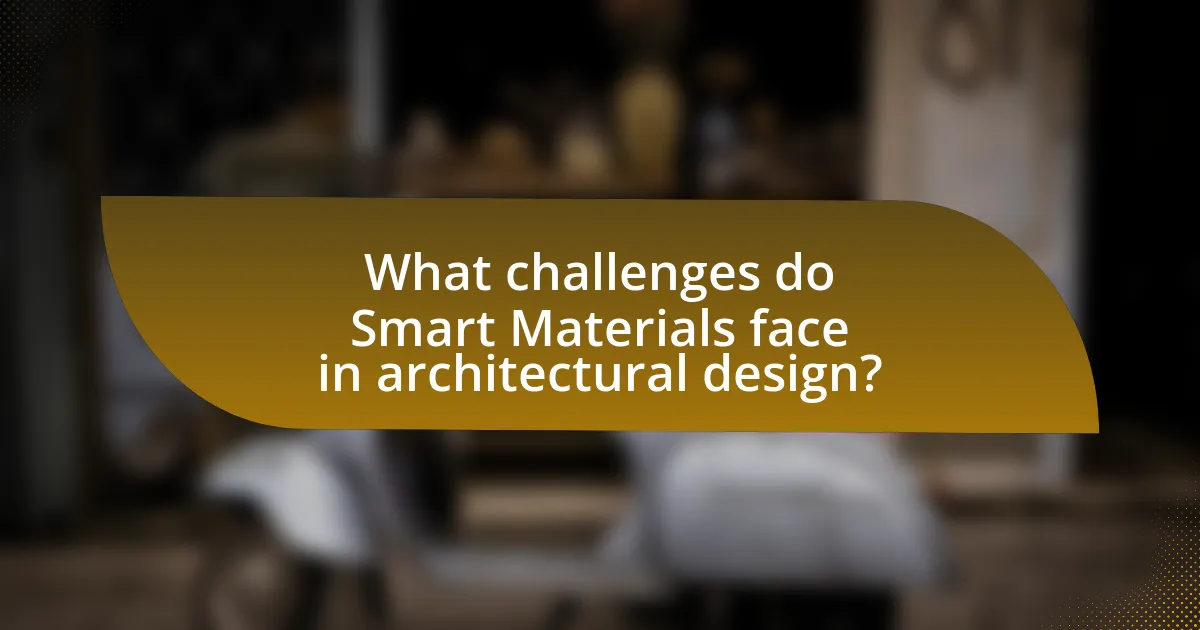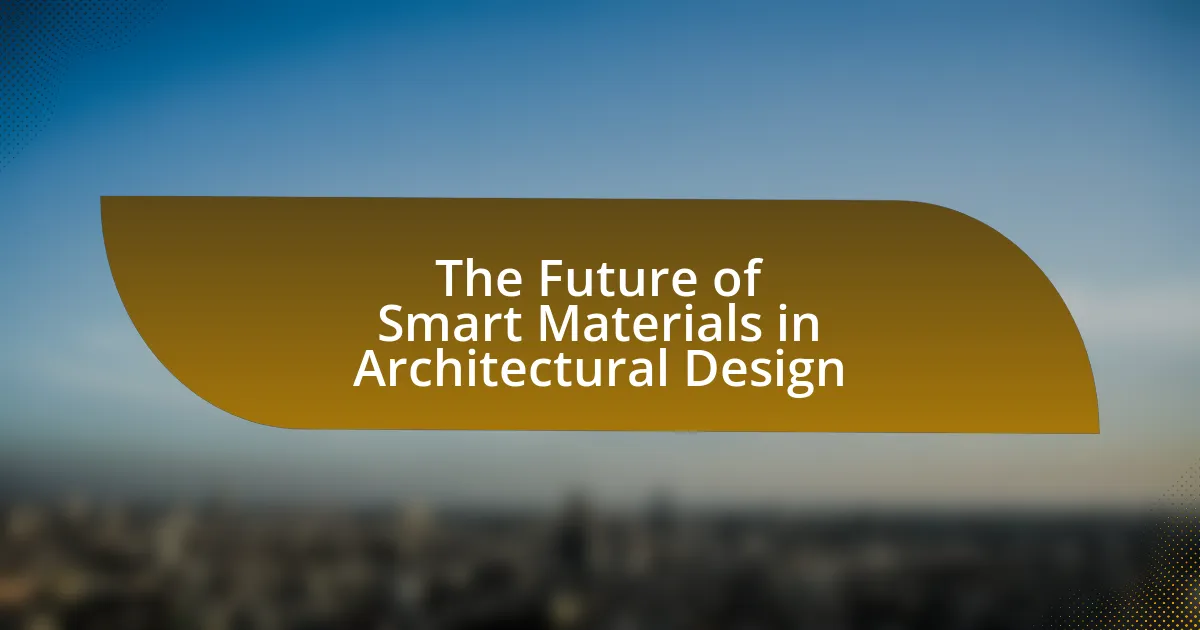Smart materials in architectural design are innovative materials that dynamically respond to environmental changes, enhancing functionality and sustainability. This article explores the characteristics, advantages, and applications of smart materials such as shape memory alloys, thermochromic substances, and self-healing concrete. It discusses how these materials differ from traditional ones, their role in improving energy efficiency and aesthetics, and the current trends and technological advancements influencing their development. Additionally, the article addresses the challenges and economic barriers to adopting smart materials, as well as best practices for architects to effectively incorporate them into their designs.

What are Smart Materials in Architectural Design?
Smart materials in architectural design are materials that can respond dynamically to environmental changes, enhancing functionality and sustainability. These materials include shape memory alloys, piezoelectric materials, and thermochromic substances, which can alter their properties in response to stimuli such as temperature, light, or mechanical stress. For instance, shape memory alloys can return to a predetermined shape when heated, allowing for adaptive structures that can change form based on environmental conditions. The integration of smart materials in architecture promotes energy efficiency and innovative design solutions, as evidenced by their increasing use in responsive facades and self-healing concrete, which can repair cracks autonomously.
How do Smart Materials differ from traditional materials?
Smart materials differ from traditional materials in their ability to respond dynamically to environmental changes. While traditional materials maintain consistent properties regardless of external conditions, smart materials can alter their characteristics, such as shape, stiffness, or conductivity, in response to stimuli like temperature, light, or stress. For example, shape-memory alloys can return to a predetermined shape when heated, showcasing their adaptive capabilities. This responsiveness allows for innovative applications in architectural design, enhancing functionality and sustainability in structures.
What properties define Smart Materials?
Smart materials are defined by their ability to respond dynamically to external stimuli, such as temperature, pressure, moisture, and electric or magnetic fields. These materials exhibit properties like shape memory, self-healing, and piezoelectricity, which allow them to change their form or function in response to environmental changes. For instance, shape memory alloys can return to a predetermined shape when heated, demonstrating their adaptability. Additionally, self-healing materials can autonomously repair damage, enhancing their longevity and performance. The integration of these properties in architectural design can lead to innovative structures that adapt to their surroundings, improving energy efficiency and occupant comfort.
How do Smart Materials respond to environmental changes?
Smart materials respond to environmental changes by altering their properties in reaction to external stimuli such as temperature, humidity, light, and stress. For instance, shape-memory alloys can return to a predetermined shape when heated, while piezoelectric materials generate an electric charge in response to mechanical stress. These adaptive characteristics enable smart materials to enhance energy efficiency and comfort in architectural design, as demonstrated by the use of thermochromic materials that change color with temperature fluctuations, thereby regulating indoor climate and reducing energy consumption.
Why is the integration of Smart Materials important in architecture?
The integration of Smart Materials is important in architecture because it enhances building performance and sustainability. Smart Materials can adapt to environmental changes, improving energy efficiency and occupant comfort. For instance, materials like shape-memory alloys and thermochromic glass respond to temperature variations, reducing the need for artificial heating and cooling. This adaptability leads to lower energy consumption, which is crucial in addressing climate change and reducing carbon footprints in the built environment. Additionally, the use of Smart Materials can contribute to innovative design solutions, allowing architects to create dynamic and responsive structures that meet modern demands for functionality and aesthetics.
What advantages do Smart Materials offer in energy efficiency?
Smart materials enhance energy efficiency by adapting their properties in response to environmental changes, thereby optimizing energy consumption. For instance, phase change materials can absorb, store, and release thermal energy, reducing the need for heating and cooling systems. Research indicates that buildings utilizing smart materials can achieve energy savings of up to 30% compared to traditional materials, as demonstrated in studies by the Lawrence Berkeley National Laboratory, which highlight the significant impact of these materials on reducing overall energy demand in architectural design.
How do Smart Materials enhance building aesthetics?
Smart materials enhance building aesthetics by enabling dynamic visual effects and adaptive designs that respond to environmental conditions. These materials can change color, texture, and transparency, allowing architects to create visually striking facades that evolve throughout the day. For instance, photochromic materials darken in response to sunlight, providing a unique appearance while also improving energy efficiency by reducing heat gain. Additionally, shape-memory alloys can be used to create structures that adjust their form, adding an element of movement and fluidity to architectural designs. This adaptability not only contributes to the visual appeal but also aligns with sustainable practices, as buildings can optimize natural light and ventilation, further enhancing their aesthetic value.

What are the current trends in Smart Materials for architectural design?
Current trends in smart materials for architectural design include the integration of self-healing materials, energy-efficient phase change materials, and responsive materials that adapt to environmental changes. Self-healing materials, such as those incorporating microcapsules, can autonomously repair damage, enhancing durability and longevity in structures. Energy-efficient phase change materials are utilized to regulate indoor temperatures by absorbing and releasing thermal energy, thereby reducing energy consumption. Responsive materials, like shape memory alloys and electrochromic glass, change their properties in response to stimuli such as temperature or light, allowing for dynamic building facades that improve energy efficiency and occupant comfort. These trends reflect a growing emphasis on sustainability and adaptability in architectural design, aligning with global efforts to create more resilient and efficient built environments.
How are advancements in technology influencing Smart Materials?
Advancements in technology are significantly enhancing the development and functionality of smart materials. Innovations in nanotechnology, for instance, allow for the creation of materials that can respond to environmental stimuli, such as temperature and light, thereby improving energy efficiency in architectural designs. Research published in the journal “Advanced Materials” highlights that the integration of sensors and actuators within smart materials enables real-time monitoring and adaptive responses, which can lead to more sustainable building practices. Furthermore, the use of machine learning algorithms in material design accelerates the discovery of new smart materials with tailored properties, as evidenced by studies from institutions like MIT, demonstrating a direct correlation between technological progress and the evolution of smart materials in architecture.
What role does nanotechnology play in Smart Materials development?
Nanotechnology plays a crucial role in the development of smart materials by enabling the manipulation of materials at the molecular or atomic level, which enhances their properties and functionalities. This manipulation allows for the creation of materials that can respond dynamically to environmental changes, such as temperature, light, or pressure. For instance, nanostructured materials can exhibit improved strength, lighter weight, and increased durability compared to traditional materials. Research has shown that incorporating nanoparticles into polymers can significantly enhance their mechanical properties and thermal stability, making them suitable for various architectural applications.
How are digital fabrication techniques utilized with Smart Materials?
Digital fabrication techniques are utilized with smart materials by enabling precise control over the material properties and geometries during the manufacturing process. These techniques, such as 3D printing and CNC machining, allow for the integration of responsive behaviors in smart materials, such as shape memory alloys and self-healing polymers, into architectural designs. For instance, researchers have demonstrated that 3D printing can create complex structures that respond to environmental stimuli, enhancing functionality and aesthetic appeal in architecture. This integration is supported by studies showing that digital fabrication can optimize the performance of smart materials, leading to innovative applications in sustainable building practices and adaptive architecture.
What are some examples of Smart Materials currently used in architecture?
Some examples of smart materials currently used in architecture include shape memory alloys, thermochromic materials, and self-healing concrete. Shape memory alloys can change their form in response to temperature variations, allowing for dynamic structural adjustments. Thermochromic materials alter their color based on temperature, providing visual cues for thermal changes and enhancing energy efficiency. Self-healing concrete contains microcapsules that release healing agents when cracks form, significantly extending the lifespan of structures. These materials are increasingly integrated into modern architectural designs to improve functionality and sustainability.
What is the role of shape-memory alloys in building design?
Shape-memory alloys (SMAs) play a significant role in building design by enabling structures to adapt to environmental changes and enhance safety. These materials can return to a predetermined shape when subjected to specific temperatures, allowing for dynamic responses to stress, temperature fluctuations, and seismic activity. For instance, in earthquake-prone areas, SMAs can be integrated into structural components to absorb and dissipate energy, thereby reducing damage during seismic events. Research has shown that incorporating SMAs can improve the resilience of buildings, as demonstrated in studies where SMA-based systems effectively mitigated structural deformation.
How are self-healing materials applied in construction?
Self-healing materials are applied in construction primarily through the integration of microcapsules or vascular networks within concrete and other building materials. These materials contain healing agents that are released when cracks occur, allowing the material to autonomously repair itself. For instance, research has demonstrated that incorporating bacteria-based self-healing agents in concrete can lead to significant improvements in durability and longevity, as evidenced by studies showing up to 50% reduction in crack propagation. This innovative application not only enhances structural integrity but also reduces maintenance costs and extends the lifespan of construction projects.

What challenges do Smart Materials face in architectural design?
Smart materials face several challenges in architectural design, including high costs, durability concerns, and integration complexities. The initial investment for smart materials can be significantly higher than traditional materials, which may deter architects and builders from adopting them. Additionally, the long-term durability of these materials is often uncertain, as their performance can degrade over time due to environmental factors. Furthermore, integrating smart materials into existing architectural frameworks requires advanced knowledge and expertise, complicating the design and construction processes. These challenges hinder widespread adoption and effective utilization of smart materials in the architectural field.
What are the economic barriers to adopting Smart Materials?
The economic barriers to adopting Smart Materials include high initial costs, limited market availability, and uncertainty regarding return on investment. High initial costs arise from the advanced technology and materials required, which can deter architects and builders from integrating them into projects. Limited market availability restricts access to these materials, making it challenging for stakeholders to source them competitively. Additionally, uncertainty regarding return on investment stems from the lack of extensive case studies demonstrating long-term savings and benefits, which can hinder decision-making for potential adopters. These factors collectively impede the widespread adoption of Smart Materials in architectural design.
How do initial costs compare to long-term benefits?
Initial costs of smart materials in architectural design are often higher than traditional materials, but the long-term benefits significantly outweigh these initial expenses. Smart materials can enhance energy efficiency, reduce maintenance costs, and improve building longevity, leading to substantial savings over time. For instance, a study by the U.S. Department of Energy found that buildings utilizing advanced materials can achieve energy savings of up to 30%, translating to lower utility bills and reduced carbon footprints. Additionally, the durability of smart materials can lead to decreased repair and replacement costs, further enhancing their long-term value.
What funding opportunities exist for Smart Materials projects?
Funding opportunities for Smart Materials projects include government grants, private sector investments, and research funding from academic institutions. For instance, the National Science Foundation (NSF) offers grants specifically for innovative materials research, including smart materials, under its Division of Materials Research. Additionally, the European Union provides funding through Horizon Europe, which supports research and innovation in advanced materials. Private companies and venture capital firms are also increasingly investing in startups focused on smart materials, recognizing their potential in various applications, including architectural design. These funding sources are crucial for advancing research and development in the field of smart materials.
What regulatory and safety concerns are associated with Smart Materials?
Regulatory and safety concerns associated with smart materials include potential toxicity, environmental impact, and compliance with building codes. Smart materials often contain chemicals that may pose health risks if not properly managed, necessitating thorough safety assessments. For instance, materials like shape memory alloys or certain polymers can release harmful substances during production or degradation, raising concerns about worker safety and environmental contamination. Additionally, smart materials must adhere to local and international building regulations, which can vary significantly, complicating their integration into architectural designs. Compliance with standards such as ISO 14001 for environmental management and ASTM standards for material safety is essential to mitigate these risks.
How do building codes impact the use of Smart Materials?
Building codes significantly influence the use of smart materials by establishing safety, performance, and sustainability standards that these materials must meet. Compliance with building codes ensures that smart materials can be integrated into construction projects without compromising structural integrity or occupant safety. For instance, the International Building Code (IBC) outlines requirements for materials used in construction, which can dictate the types of smart materials that are permissible based on their fire resistance, load-bearing capacity, and environmental impact. This regulatory framework encourages innovation while ensuring that new technologies, such as self-healing concrete or energy-efficient smart glass, adhere to established safety and performance benchmarks.
What safety standards must Smart Materials meet?
Smart materials must meet safety standards such as ASTM International standards, ISO 9001 quality management systems, and specific building codes relevant to their application in architecture. These standards ensure that smart materials are reliable, durable, and safe for use in construction. For instance, ASTM standards provide guidelines for testing the performance and safety of materials, while ISO 9001 ensures consistent quality in manufacturing processes. Compliance with these standards is crucial for minimizing risks associated with structural integrity and occupant safety in architectural design.
How can architects effectively incorporate Smart Materials into their designs?
Architects can effectively incorporate Smart Materials into their designs by integrating materials that respond dynamically to environmental changes, enhancing functionality and sustainability. For instance, using phase-changing materials can help regulate indoor temperatures, reducing energy consumption by up to 30% in buildings, as demonstrated in studies by the Lawrence Berkeley National Laboratory. Additionally, architects can employ self-healing concrete, which can repair its own cracks, extending the lifespan of structures and reducing maintenance costs. By selecting materials that offer these advanced properties, architects not only improve the performance of their designs but also contribute to sustainable building practices.
What best practices should architects follow when selecting Smart Materials?
Architects should prioritize functionality, sustainability, and compatibility when selecting smart materials. Functionality ensures that the materials meet specific performance criteria, such as energy efficiency or adaptability to environmental changes. Sustainability involves choosing materials that minimize environmental impact, such as those with low embodied energy or that are recyclable. Compatibility requires that the selected materials integrate seamlessly with existing structures and systems, ensuring durability and ease of maintenance. Research indicates that incorporating these best practices can enhance building performance and reduce lifecycle costs, as evidenced by studies showing that sustainable materials can lower energy consumption by up to 30%.
How can collaboration with material scientists enhance design outcomes?
Collaboration with material scientists enhances design outcomes by integrating advanced material properties into architectural projects. This partnership allows designers to leverage innovative materials that offer improved performance, sustainability, and aesthetic qualities. For instance, the use of smart materials, such as shape-memory alloys and self-healing concrete, can lead to structures that adapt to environmental changes and reduce maintenance costs. Research published in the Journal of Architectural Engineering demonstrates that buildings utilizing these materials can achieve energy efficiency improvements of up to 30%. Thus, the collaboration between architects and material scientists directly contributes to more functional, sustainable, and visually appealing designs.
What future developments can we expect in Smart Materials for architecture?
Future developments in smart materials for architecture will likely include enhanced self-healing capabilities, energy efficiency improvements, and increased integration with digital technologies. Research indicates that materials capable of autonomously repairing themselves can significantly extend the lifespan of structures, reducing maintenance costs and resource consumption. For instance, bio-inspired materials that mimic natural healing processes are being developed, which can respond to damage by regenerating their structure. Additionally, advancements in energy-efficient materials, such as phase-changing materials that regulate temperature, are expected to optimize energy use in buildings. The integration of smart sensors and IoT technology will further enable real-time monitoring and adaptive responses to environmental changes, enhancing the functionality and sustainability of architectural designs.
How might Smart Materials evolve with emerging technologies?
Smart materials are likely to evolve significantly with emerging technologies such as artificial intelligence, nanotechnology, and advanced manufacturing techniques. These technologies will enable the development of materials that can adapt to environmental changes, enhance energy efficiency, and improve structural performance. For instance, AI can optimize the design and functionality of smart materials by analyzing data from various sources, leading to innovations like self-healing concrete or responsive facades that adjust to sunlight. Nanotechnology will allow for the creation of materials with enhanced properties at a molecular level, such as increased strength or reduced weight, which can be crucial in architectural applications. Advanced manufacturing techniques, including 3D printing, will facilitate the production of complex geometries and customized smart materials, making them more accessible and cost-effective for architectural design.
What potential innovations could reshape architectural design?
Potential innovations that could reshape architectural design include the integration of smart materials, which can adapt to environmental changes and enhance energy efficiency. For instance, materials like thermochromic and photochromic substances change their properties in response to temperature and light, respectively, allowing buildings to regulate temperature and light levels naturally. Research from the Massachusetts Institute of Technology highlights that these materials can significantly reduce energy consumption by optimizing heating and cooling needs. Additionally, advancements in 3D printing technology enable the creation of complex structures with reduced waste and increased customization, as demonstrated by projects like the ICON 3D-printed homes in Austin, Texas, which showcase rapid construction and cost-effectiveness. These innovations collectively promise to transform architectural practices by promoting sustainability and efficiency.
What practical tips can architects use to stay updated on Smart Materials?
Architects can stay updated on Smart Materials by regularly attending industry conferences and workshops focused on innovative building technologies. These events often feature presentations from leading experts and showcase the latest advancements in Smart Materials, providing architects with firsthand knowledge and networking opportunities. Additionally, subscribing to relevant journals and publications, such as the Journal of Architectural and Planning Research, can keep architects informed about recent research findings and case studies. Engaging with online platforms and forums dedicated to architectural innovation, like ArchDaily or the American Institute of Architects (AIA) website, allows architects to participate in discussions and access resources related to Smart Materials. Lastly, collaborating with material scientists and engineers can provide architects with insights into the practical applications and performance of Smart Materials in real-world projects.
